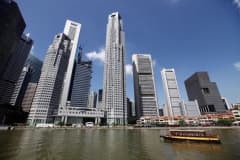Why Singapore’s economy looks set for a contraction
Published: Tuesday, 1 Oct 2013 | 12:50 AM ET
By: Dhara Ranasinghe | Senior Writer

If recent weaker-than-expected economic data from Singapore is anything to go by, the city-state is heading for a quarterly growth contraction, economists say.
A negative quarterly gross domestic product (GDP) reading for the third quarter should not be a surprise given an unusually firm annualized quarter-on-quarter rise of 15.5 percent in the second quarter, but the scale of the contraction is something to watch for, they add. The latest GDP data is expected later this month.
CIMB Regional Economist Seng Wun Song forecasts that Singapore's economy probably contracted 2-3 percent on a seasonally adjusted, quarter-on-quarter annualized basis in the third quarter. Hak Bin Chua, an economist at Bank of America Merrill Lynch (BoAML), is looking for a 4-5 percent contraction.
"It is a case of two steps forward, one step back for Singapore's economy," said CIMB's Song. "It's not that we are heading back down the hill, but the recovery is fragile."
And that's something the latest economic numbers highlight: data last week showed industrial production rose 3.5 percent on year in August, missing market expectations for a 4.9 percent rise.
On a monthly basis, output has declined for three months in a row, falling 1.4 percent in August.
Non-oil domestic exports, one of Singapore's most closely-watched economic indicators, fell 6.2 percent in August from a year earlier – an unexpected decline.
"The quarterly number for Q3 GDP is likely to be negative because the surge was so strong in the second quarter and also because recent data has been weaker-than-expected," said Chua at BoAML. "The year-on-year number should still be positive and the bigger picture is that the services sector continues to be a driver of growth."
Analysts at OCBC Bank said in a note on Tuesday that they tipped third quarter GDP growth at 2.3 percent on-year, with a 9.4 percent contraction on-quarter, in seasonally adjusted annualized basis.
Singapore, home to one of Asia's biggest financial centers, is export-dependent, which makes it vulnerable to what's happening in the global economy, analysts said.
"There is growth in the Singapore economy, it's just not in the straight line we'd hoped for and that's partly due to worries about the impact of Fed tapering, the strength of the rebound in China and the impact of currency weakness in neighboring Asian countries," said Song.
Worries about an unwinding of the U.S. Federal Reserve's monetary stimulus program have unsettled global markets in recent months and hurt emerging market currencies such as the Indonesian rupiah as markets brace for a tightening of liquidity conditions.
—By CNBC.Com'sDhara Ranasinghe; Follow her on Twitter<iframe id="twitter-widget-0" class="twitter-tweet twitter-tweet-rendered" scrolling="no" frameborder="0" allowtransparency="true" title="Embedded Tweet" style="width: 1px; height: 1px; border-style: none; position: absolute;"></iframe>
Published: Tuesday, 1 Oct 2013 | 12:50 AM ET
By: Dhara Ranasinghe | Senior Writer

If recent weaker-than-expected economic data from Singapore is anything to go by, the city-state is heading for a quarterly growth contraction, economists say.
A negative quarterly gross domestic product (GDP) reading for the third quarter should not be a surprise given an unusually firm annualized quarter-on-quarter rise of 15.5 percent in the second quarter, but the scale of the contraction is something to watch for, they add. The latest GDP data is expected later this month.
CIMB Regional Economist Seng Wun Song forecasts that Singapore's economy probably contracted 2-3 percent on a seasonally adjusted, quarter-on-quarter annualized basis in the third quarter. Hak Bin Chua, an economist at Bank of America Merrill Lynch (BoAML), is looking for a 4-5 percent contraction.
"It is a case of two steps forward, one step back for Singapore's economy," said CIMB's Song. "It's not that we are heading back down the hill, but the recovery is fragile."
And that's something the latest economic numbers highlight: data last week showed industrial production rose 3.5 percent on year in August, missing market expectations for a 4.9 percent rise.
On a monthly basis, output has declined for three months in a row, falling 1.4 percent in August.
Non-oil domestic exports, one of Singapore's most closely-watched economic indicators, fell 6.2 percent in August from a year earlier – an unexpected decline.
"The quarterly number for Q3 GDP is likely to be negative because the surge was so strong in the second quarter and also because recent data has been weaker-than-expected," said Chua at BoAML. "The year-on-year number should still be positive and the bigger picture is that the services sector continues to be a driver of growth."
Analysts at OCBC Bank said in a note on Tuesday that they tipped third quarter GDP growth at 2.3 percent on-year, with a 9.4 percent contraction on-quarter, in seasonally adjusted annualized basis.
Singapore, home to one of Asia's biggest financial centers, is export-dependent, which makes it vulnerable to what's happening in the global economy, analysts said.
"There is growth in the Singapore economy, it's just not in the straight line we'd hoped for and that's partly due to worries about the impact of Fed tapering, the strength of the rebound in China and the impact of currency weakness in neighboring Asian countries," said Song.
Worries about an unwinding of the U.S. Federal Reserve's monetary stimulus program have unsettled global markets in recent months and hurt emerging market currencies such as the Indonesian rupiah as markets brace for a tightening of liquidity conditions.
—By CNBC.Com'sDhara Ranasinghe; Follow her on Twitter<iframe id="twitter-widget-0" class="twitter-tweet twitter-tweet-rendered" scrolling="no" frameborder="0" allowtransparency="true" title="Embedded Tweet" style="width: 1px; height: 1px; border-style: none; position: absolute;"></iframe>




